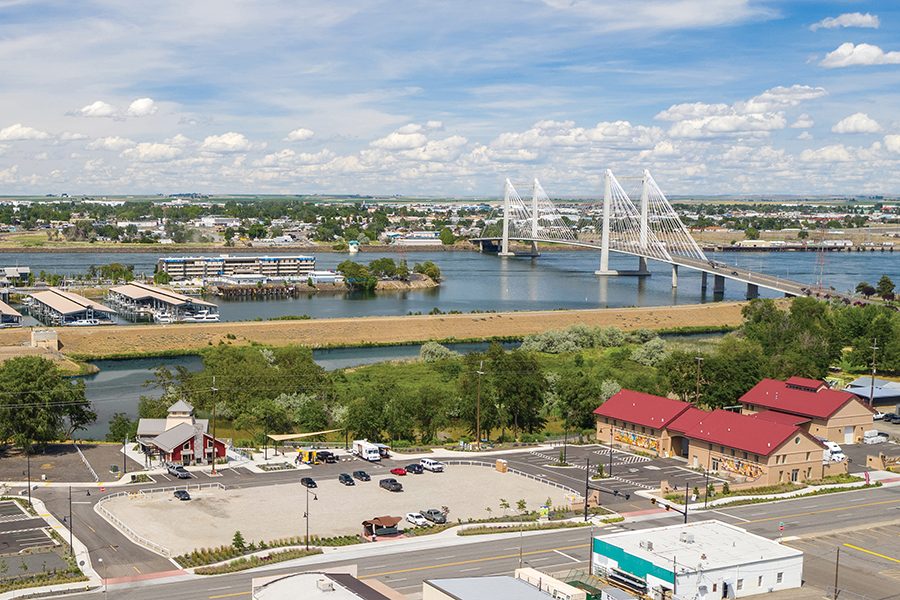
Home » Market Overview: Covid chaos clouds future of Tri-City real estate
Market Overview: Covid chaos clouds future of Tri-City real estate

October 15, 2020
Tri-City real estate broker Charles Laird was vacationing in his native Scotland in March when national borders began to close because of the spreading threat of coronavirus.
Laird and his family cut their trip short and headed home, a journey that included driving on Interstate 5 through pandemic-stricken Seattle.
The chronically congested freeway was all but empty. Laird counted five other vehicles. The new world, he said, was eerie.
It was an apt break between the pre-Covid era, when commercial real estate was booming, and the reality of the new crisis.
All quarters of the Tri-City real estate market were thriving prior to the pandemic. Residential, office, retail, multifamily, industrial and agricultural properties were in heavy demand from buyers and tenants.
It was “unprecedented,” and not just at Tippett Co., where Laird focuses on commercial property sales and leasing with a focus on agriculture. Tippett also advises on brokerage, development and offers property management services.
“We were all busy. Phones were ringing. There was stuff going on on a scale I haven’t experienced before,” he said.
As Washington hunkered down under the Stay Home, Stay Healthy order and subsequent phased Safe Start program, the phones rang less often.
Covid-19 created winners and losers.
Residential
The residential market remains strong, fueled by low interest rates and demand that exceeds supply.
The current inventory is about a third of normal and many of the properties listed are unbuilt. It’s not enough to meet demand. And it’s not enough to occupy all 1,100-plus Realtors operating in the Mid-Columbia.
Jeff Losey, president of the Home Builders Association of Tri-Cities, called the market baffling. Normally, high unemployment is bad for homebuilders. In August, the local unemployment rate was 8.5%
“No jobs, no pay, no house. You’ve got to qualify (for a loan),” he said.
But homes continue to sell quickly and prices are rising.
“It’s great if you’re selling,” he said. It’s not great for a healthy residential market.
“Arguably it’s an unhealthy market.”
Losey said the picture could darken because of a chronic shortage of skilled labor and a crisis in lumber prices.
Lumber prices have soared in recent months, adding about $16,000 to the cost of a typical new home. The National Association Home Builders is pushing for better trade policies and increased domestic production.
But hurricanes, which drive up demand for building materials, won’t help. And West Coast forest fires curtailed logging in Oregon for at least part of September.
“It could lengthen the amount of time it’s going to take to build a home,” he said.
Commercial
Deal volumes are way down, according to MLS data for Kennewick, Pasco and Richland. The numbers reflect the year through September and exclude areas outside the three cities and deals processed through other listing services.
Caveats aside, the MLS figures confirm the cooling trend.
Office building sales were down 35% from where they were a year ago on a per-square-foot basis. Office leasing was down 30%. Retail building sales were down 90% and retail leasing by 42%.
In real terms, seven office buildings and three retail buildings sold in the Tri-Cities through mid-September, compared to 18 and 17, respectively, during the same period in 2019.
It’s unclear what that portends for commercial real estate.
Land will continue to attract investors, Laird said.
“If you look at the sectors, the demand for land has been pretty solid. I don’t think that’s going to change. People are still comfortable buying land,” he said.
Development is strong now but the future is uncertain.
There is plenty of commercial construction taking place in the Tri-Cities. Most of it was authorized before the pandemic.
The construction industry is hopeful a stimulus package will keep government spending going as private investment is expected to taper off in the coming year. As of late September, no stimulus package had been approved.
Pre-pandemic public investments in infrastructure included roads, schools and fire stations, and that excludes federal spending at the Hanford site.
Notable local examples include site work at the Port of Kennewick’s Vista Field redevelopment, fire station projects in all three of the Tri-Cities, a taxiway project at the Tri-Cities Airport in Pasco and Richland’s Duportail Bridge and related road upgrades.
The private sector is investing in apartments, agricultural facilities and strip malls.
Two apartment projects are being built on the Columbia River — one in Pasco and the other in Richland. Richland’s prized Park Place gateway project is nearly finished, adding new retail space and more than 100 apartments overlooking Howard Amon Park.
Kennewick has approved hundreds of apartments and a three-bay strip mall is nearing completion by J.C. Penney at Columbia Center. Kenyon Zero Storage is completing its latest cold storage warehouse in Pasco.
What will the future bring?
Laird predicts agriculture investment will continue.
But office and retail space are less certain.
Retail, which includes restaurant spaces, has been slammed by the pandemic, as has the hospitality industry, notably hotels.
Some won’t reopen. The Bookworm in Richland and Cousin’s Restaurant in Pasco are just two local businesses that have announced they won’t come back after the pandemic. Both will leave vacant space.
Office space poses the biggest challenge because no one knows if or when workers will return after being sent home during the pandemic, Laird said.
If that’s the new normal, there will be less demand, which will pressure owners to cut rents.
Some are investing in costly measures such as touchless doors and automatic temperature scanners to reassure tenants and their employees that it’s safe to come back.
If employees return, they could need more space to maintain social distancing, which in theory will increase demand for rentable space.
“There’s a lot of unknowns,” Laird said.
Construction + Real Estate
KEYWORDS october 2020





